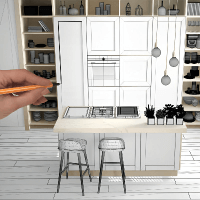Shop for Financing as Carefully as You Do for Cabinets or Appliances
The typical budget for a kitchen remodel is 10% to 25% of home’s value. That is a major investment, but a carefully planned project will provide a good return and an improved standard of living. If you will be borrowing money for the project, there are a number of options.
Expect the loan application process to take three to four weeks for projects below $400,000 and longer for those costing more. When calculating the cost of each loan, include the cost of credit reports, loan origination fees, appraisals, closing costs and interest. Then, subtract anticipated tax benefits. Just as you will shop for the best value on kitchen cabinets or appliances, you should shop for a loan. Compare different types of loans, rates and terms across several lenders before making a decision. Below are brief descriptions of some sources of funding for remodeling projects:
1. Take out a Construction Loan
This is a short-term loan, usually at a high interest rate. It allows you to draw what you need at each point in construction. You convert this to another type of mortgage when construction is complete. When shopping for a loan, look for a future-value construction loan package. This type of package will allow you to draw cash as you need it during construction, then automatically transitions to a permanent mortgage when the project is complete.
2. Borrow Against the Equity in Your Home
Equity is the home’s value minus the amount remaining on your current mortgage. Money borrowed against home equity without paying off the existing mortgage is a home equity loan. The interest on a home equity loan is tax deductible. There are two types of home equity loans. A home equity line of credit (HELOC) allows you to draw funds as needed to make contractor payments. You pay interest only on what you owe at any time. A second mortgage gives you the full amount of cash at the time you take out the loan. You pay interest on the full loan amount from Day 1.
3. Refinance With Cash Out
If your home is worth more than you owe on your mortgage, you may be able to refinance, borrowing enough to pay off the first mortgage and have cash left over for your remodel project.
4. Use an Energy-Efficient Mortgage (EEM)
If your improvements will increase your home’s energy efficiency to meet the program’s standards, it is assumed you will have lower energy bills and a higher-value property after the work. You will be able to borrow more than with other mortgages, but will have to meet stringent requirements.
5. Buy or Refinance With an FHA 203(k) Loan or Fannie May Homestyle Renovation Mortgage
These mortgages roll the purchase price and renovation cost together into one loan. Dollar limits vary by region, but will cover typical kitchen remodels and more. Requirements regarding escrow, inspections and contractor payments are complex and challenging. There is also the Streamlined 203(k), written for small amounts and much easier to process.
6. Borrow Against Stocks or Other Resources
Your credit union or brokerage may extend a personal loan with stocks or another asset as collateral. As with a home equity loan, you will have complete control over the funds.
Thanks to veteran loan officer Gail Vinje of American Mortgage and Equity Consultants, Inc. and renovation expert John Sylvestre of Sylvestre Construction for their assistance with this article.
Do you have questions or comments about how to finance a kitchen renovation? Leave a message below for our readers.











